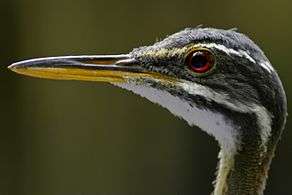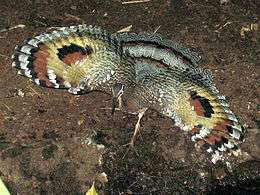Sunbittern
| Sunbittern | |
|---|---|
| | |
| on Cristalino River Southern Amazon, Brazil | |
| Scientific classification | |
| Kingdom: | Animalia |
| Phylum: | Chordata |
| Class: | Aves |
| Infraclass: | Neognathae |
| Order: | Eurypygiformes |
| Family: | Eurypygidae Selby, 1840 |
| Genus: | Eurypyga Illiger, 1811 |
| Species: | E. helias |
| Binomial name | |
| Eurypyga helias (Pallas, 1781) | |
_Area.svg.png) | |
| Sunbittern range | |
The sunbittern (Eurypyga helias) is a bittern-like bird of tropical regions of the Americas, and the sole member of the family Eurypygidae (sometimes spelled Eurypigidae) and genus Eurypyga. It ranges from Guatemala to southern Peru, showing three extant subspecies. The sunbittern shows both morphological and molecular similarities with the kagu (Rhynochetos jubatus) of New Caledonia, indicating an gondwanic origin, being both placed in the clade Eurypygiformes.[2]
Taxonomy
The sunbittern is usually placed in the Gruiformes, but this was always considered preliminary. Altogether, the bird is most similar to another bird that was provisionally placed in the Gruiformes, the kagu (Rhynochetos jubatus).[3] Molecular studies seem to confirm that the kagu and sunbittern are each other's closest living relatives and have a similar wing display.[4][5] They are probably not Gruiformes (though the proposed Metaves are just as weakly supported).[6] Altogether, the two species seem to form a minor Gondwanan lineage which could also include the extinct adzebills and/or the mesites, and is of unclear relation to the Gruiformes proper. Notably, the kagu and mesites also have powder down.
Subspecies
There were formerly two species (E. helias and E. major), but now E. helias is divided into three subspecies differentiated by plumage characters and size. The three subspecies are apparently allopatric.[2]
- E. h. helias. East of the Andes in lowland tropical South America, from the Orinoco basin, through the Amazonia.
- E. h. major. Found at various altitudes ranging from southern Guatemala to Ecuador.
- E. h. meridionalis. Found in southern central Peru, in the lower subtropical zone (800–1830m).
Description
The bird has a generally subdued coloration, with fine linear patterns of black, grey and brown. Its remiges however have vividly colored middle webs, which with wings fully spread show bright eyespots in red, yellow, and black. These are shown to other sunbitterns in courtship and threat displays, or used to startle potential predators. Male and female adult sunbitterns have can be differentiated by small differences in the feather patterns of the throat and head. Like some other birds, the sunbittern has powder down.
The sunbittern has a long and pointed bill, a short hallux as in shorebirds and rails, and orange-yellow feet in the lowland individuals in the east of the Andes, while those of the Central America species (E. h. major) are much redder.[2]
 head
head wing display
wing display song
song
The sunbittern's range extends from Guatemala to Brazil, in the humid Neotropical forests, generally with and open understorey and near rivers and streams. The species may also be present in southern Mexico. It has been traditionally reported from the Atlantic slope of Chiapas, but no specimens are known and there have been no recent records.[7]
Behaviour and ecology
The sunbittern is a non-migrant bird that is normally found foraging on the ground and scratching for insects. They are cryptic birds that display their large wings, that exhibits a pattern that resemble eyes, when they feel threatened. Sunbitterns start nesting in the early wet season and before it starts they make flight displays 10–15 m high in the forest canopy. They build open nests in trees, and lay two eggs with blotched markings. The young are precocial, but remain in the nest for several weeks after hatching.[2][8]
References
- ↑ BirdLife International (2012). "Eurypyga helias". IUCN Red List of Threatened Species. Version 2013.2. International Union for Conservation of Nature. Retrieved 26 November 2013.
- 1 2 3 4 del Hoyo, J. Elliott, A. & Sargatal, J. (editors). (1996) Handbook of the Birds of the World. Volume 3: Hoatzin to Auks. Lynx Edicions. ISBN 84-87334-20-2
- ↑ Houde et al. (1997) Phylogeney and evolution of 12S rDNA in Gruiformes (Aves). In: Mindell, D. P. (ed.), Avian Molecular Evolution and Systematics. Academic Press, San Diego. Pp. 121–158.
- ↑ Fain & Houde (2004) Parallel radiations in the primary clades of birds. Evolution 58(11): 2558–2573.
- ↑ Ericson et al. (2006) Diversification of Neoaves: Integration of molecular sequence data and fossils. Biology Letters 2 (4): pp. 543–547
- ↑ Morgan-Richards et al. (2008) Bird evolution: testing the Metaves clade with six new mitochondrial genomes. BMC Evolutionary Biology 8 (20).
- ↑ Howell, Steve N. G. and Webb, Sophie (1995) A guide to the birds of Mexico and Northern Central America ISBN 0-19-854012-4
- ↑ Archibald, George W. (1991). Forshaw, Joseph, ed. Encyclopaedia of Animals: Birds. London: Merehurst Press. p. 100. ISBN 1-85391-186-0.
External links
- BirdLife Species Factsheet
- Sunbittern videos, photos & sounds on the Internet Bird Collection
| Wikimedia Commons has media related to Eurypiga helias. |
